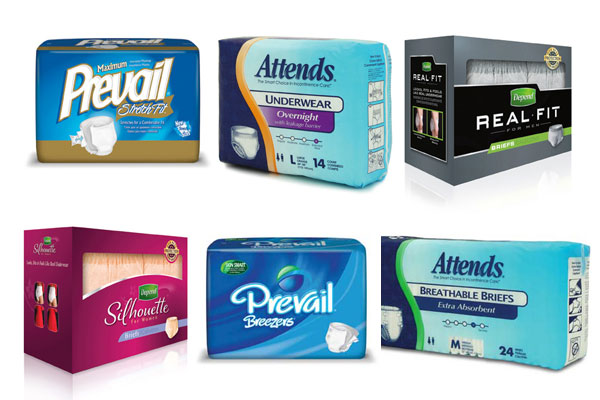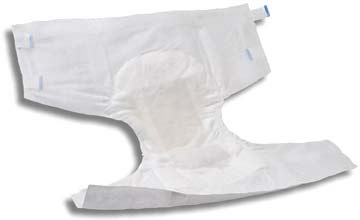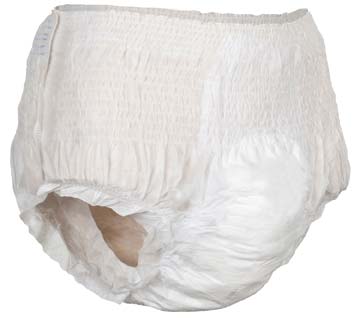November 12-16 is Bladder Health Awareness Week, a great time for HME providers to develop a local awareness campaign and/or in-store promotions built around incontinence products. The impending holiday season can also increase demand for incontinence products, as customers seek to eliminate anxiety or possible embarrassment when participating in holiday festivities and family gatherings.
But the need for incontinence products is a year-round reality for many customers coming to any HME location. Providers are especially well-positioned to provide information and resources to guide product choices.
“Consumers are more savvy in their purchasing than ever before, but they usually need help with this product category to feel confident that the quality of the products they are purchasing will meet their individual needs,” says Melissa DeMarinis of SCA Americas’ health care marketing team.
“Offering educational pieces and being available to answer questions discreetly, perhaps with a call line, will help consumers make the right product choice and become loyal to the provider who has helped them maintain their quality lifestyle.”
Providers can guide customers as they choose among the various products. There are more choices than ever, and many of them are targeted to specific needs. SCA America, for example, offers pads, cottony-soft underwear and “ultra thins” for women, and superabsorbent underwear and protective guards for men. The variety of gender-specific choices across a range of manufacturers expands the numbers of various pads, liners, briefs, guards, collector garments, panties, etc.
When navigating the choices, incontinence products offer an opportunity for providers to be allies to customers and to offer guidance and help that isn’t available from competitors such as big-box retailers.
Stigmatized and Under-Reported
Incontinence affects some 200 million people worldwide and about 25 million adult Americans experience transient or chronic incontinence. The National Association for Continence (NAFC) estimates that 75-80 percent of sufferers are women. In fact, one in four women over the age of 18 experiences episodes of involuntary urine leakage.
A common misconception is that incontinence is an inevitable part of getting older. In fact, proper management of weight and beverage consumption and performing pelvic floor muscle exercises can enable excellent bladder control well into old age. NAFC calls urinary incontinence “a stigmatized, under-reported, under-diagnosed and under-treated condition.”
“The loss of bladder control affects millions of Americans,” says Eric Rovner, M.D., professor of urology at the Medical University of South Carolina. “As our older population continues to grow, so will the need for high-performance incontinence products that both protect the skin and a person’s dignity.”

Perhaps because they are embarrassed, patients tend to avoid seeking medical help for bladder problems. Women typically wait six and a half years from the first time they experience symptoms until they obtain a diagnosis. Two-thirds of individuals who experience loss of bladder control symptoms don’t use any treatment or product to manage their incontinence. Men are less likely to be diagnosed than women, are less likely to talk about the problem with friends and family and are more likely to be uninformed, according to NAFC.
The sensitivity of incontinence issues makes it critical that a provider offer a private area for consultation. The hesitancy to discuss the subject also raises the value of point-of-sale materials such as selection guides mounted on a retail shelf, or even product selection information printed on packaging.
A lack of information and education among the customer base makes it all the more important that providers be knowledgeable about incontinence in general and product offerings to guide their customers. NAFC offers information on its website and also printed materials, available through bulk purchase to hand out in a retail establishment, including the provider’s logo or brand on larger quantities.
“Offering personal help and guidance differentiates the HME provider from a big-box retailer,” says Nancy Muller, executive director of the NAFC. “There is a tremendous opportunity for providers to play a role in educating the public and education happens at the local level. Customers are looking for value from the shopping experience and value builds loyalty. Home care providers must prepare themselves to provide guidance and information to their customers.”
Addressing Specific Needs
 Many consumers have little idea how sophisticated today’s incontinence products are, including inner layers to promote absorbency and outer layers to prevent leakage. Some products have layers with microscopic pores to funnel fluid in one direction to avoid having urine leak back onto skin. Products are also designed specifically to be worn at night, when higher production of urine may cause a problem for someone who has no problem during the day. The range of closure designs include re-closeable tapes and hook-and-loop (Velcro) fasteners to ensure flexibility and economic practicality, as well as fit.
Many consumers have little idea how sophisticated today’s incontinence products are, including inner layers to promote absorbency and outer layers to prevent leakage. Some products have layers with microscopic pores to funnel fluid in one direction to avoid having urine leak back onto skin. Products are also designed specifically to be worn at night, when higher production of urine may cause a problem for someone who has no problem during the day. The range of closure designs include re-closeable tapes and hook-and-loop (Velcro) fasteners to ensure flexibility and economic practicality, as well as fit.
Addressing the needs of a customer requires careful fit in addition to product selection. Bigger does not mean better, and an ill-fitting product is more likely to leak. Using smaller, better-fitting products is also less expensive, since large products tend to cost more.
Muller observes that smaller HME providers would likely carry a limited number of brands and should therefore choose a supplier with a wide product line to provide the largest number of options. Providers should also offer reusable products as well as disposables to differentiate themselves from big-box stores that typically carry only disposables.
Providers should be aware that, according to NAFC focus groups, many consumers use a combination of products such as a disposable insert along with a reusable, washable garment that feels more like underwear. The disposable insert provides absorbency and controls odor. “Providers should think about how the products they stock might be used in combination,” Muller says. Awareness of the contrast between nighttime and daytime usage is also critical, especially among older customers whose nighttime urine production can be greater.
Judging product performance has historically been a challenge in the incontinence market, and a council headed by NAFC is in the process of developing national quality performance standards for disposable adult absorbent products for incontinence in the frail, elderly and/or disabled populations. The council is focusing on products provided and paid for by five states in their Medicaid waiver programs, which allow people to be cared for in their homes rather than institutions. Facing an influx of questionable quality products, new distributors and mail-order companies entering the market, the states sorely needed a way to judge the quality and performance of incontinence products.
Measuring Product Performance
 The NAFC’s council of experts has been meeting monthly for the last year and a half to develop draft recommendations, which are now open for commentary and feedback. Members of the council consist of individuals responsible for managing the Medicaid waiver programs for their respective states—California, Massachusetts, Minnesota, Texas and South Carolina—and technical directors from nonwovens manufacturers in the United States, including Attends, First Quality, Kimberly Clark and SCA.
The NAFC’s council of experts has been meeting monthly for the last year and a half to develop draft recommendations, which are now open for commentary and feedback. Members of the council consist of individuals responsible for managing the Medicaid waiver programs for their respective states—California, Massachusetts, Minnesota, Texas and South Carolina—and technical directors from nonwovens manufacturers in the United States, including Attends, First Quality, Kimberly Clark and SCA.
The council has recommended development of measurements to assess product properties related to eight characteristics:
- A product’s “rewet” ability to withstand multiple incontinent episodes
- The “rate of acquisition,” or speed at which urine is drawn away from the skin
- Retention capacity, or the ability to hold fluid without leaking
- Sizing options, including youth and adult sizes
- Safety of product components, as listed by any federal regulatory agency
- Closure systems, which should be “mechanical” to allow multiple refastenings
- “Breathable zones” to allow air flow to release trapped body heat and perspiration
- Fit and ability to contain fecal matter
Although initiated to address state Medicaid needs, the recommendations are also considered applicable to consumer purchases of retail product as well as products purchased for use by hospitals, nursing homes, hospice centers and similar facilities. “We hope the standards will gain traction for adult absorbent products in general,” Muller says. “We want to raise the bar and eliminate substandard products that seem to be popping up in the marketplace.” Better overall information for consumers of incontinence products can benefit HME providers and their customers. Another goal is to simplify testing to eliminate repetition of effort and encourage sharing of information.
“We’re not a standards board,” says Muller. “We tried to write the characteristics from the consumer’s point of view, not as a set of manufacturing specs. We really want it to represent the patient or consumer’s well-being.”
Measuring the effectiveness of incontinence products fits perfectly into the evolving “pay for performance” environment of today’s health care system. “Quality performance characteristics matter,” according to Muller. “It’s time for everyone to get on board and understand what performance characteristics are all about.”
The NAFC standards are also a means of “harnessing the quality and technology in the marketplace,” she adds. “We wanted manufacturers around the table. This technology is available today. Let’s make sure the frail and indigent are provided the quality products and the dignity they deserve.” The complete draft recommendations can be found on NAFC’s website. They were publicly vetted for commentary for a 60-day period that ended in September and final recommendations will be released by the end of the year.
Plethora of Products
As for the products themselves, there are a wide variety of styles available from a number of different companies that offer an array of benefits and address particular levels of incontinence. Attends Healthcare Products offers protective underwear in quite a few styles—overnight and extra absorbency, for example—as well as briefs (including bariatric and youth sizes), pads and pants, underpants, washcloths and tissues. Its website (see sidebar) features a helpful “frequently asked questions” section addressing topics such as product selection, sizing concerns, purchasing locations and key benefits. First Quality offers the Prevail product line of Stretchfit adult briefs with elastic side panels for moderate to heavy incontinence protection in addition to protective underwear that fits like regular undergarments, adult briefs for all sizes, bladder control pads shaped to the body with cloth-like outer fabric, belted shields with reinforced buttonholes to prevent leakage, contoured pant liners, underpads for furniture protection and adult incontinence washcloths.
Depend products from Kimberly-Clark are broken into separate lines for women and men. The Silhouette line of briefs and other underwear styles for women offers adjustable fits and protection with tabs. Men can choose from Real Fit briefs and Depend guards, also offering adjustable fits and tabs. Tranquility Incontinence Products provides protection in categories including light protection (Trimshield mini and super-plus pads), moderate protection (washable pants, adjustable belted undergarments, etc.), heavy protection (SlimLine disposable briefs and bariatric stretch pants), maximum protection—“all through the night” disposable briefs and large-size underpads, for example—and added protection (the TopLiner range of pads), along with a selection of extra-care products such as cleansing wipes and protective gloves. Wearever’s most popular brands include men’s classic incontinence briefs, women’s lovely lacy trim incontinence panties and cotton comfort incontinence panties.
Understanding the nature of the market—and the needs of your customers—will allow these products to continue as a high-performance revenue stream for full-service HME/DME providers.
Incontinence Online
Attends Healthcare Products
www.attends.com
First Quality
www.firstquality.com
Kimberly-Clark Corporation
www.kimberly-clark.com
National Association for Continence (NAFC)
www.nafc.org
Tranquility Products
www.tranquilityproducts.com
SCA Americas
www.sca.com
Wearever
www.weareverincontinence.com




